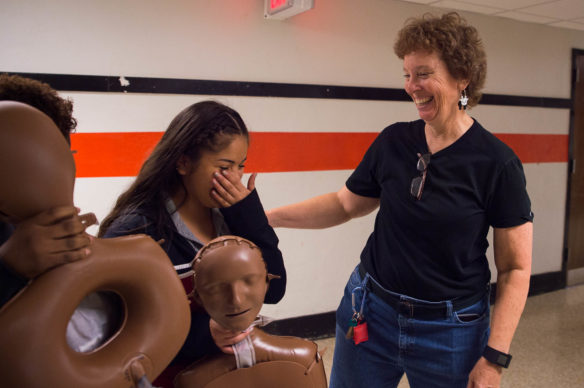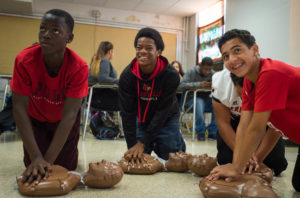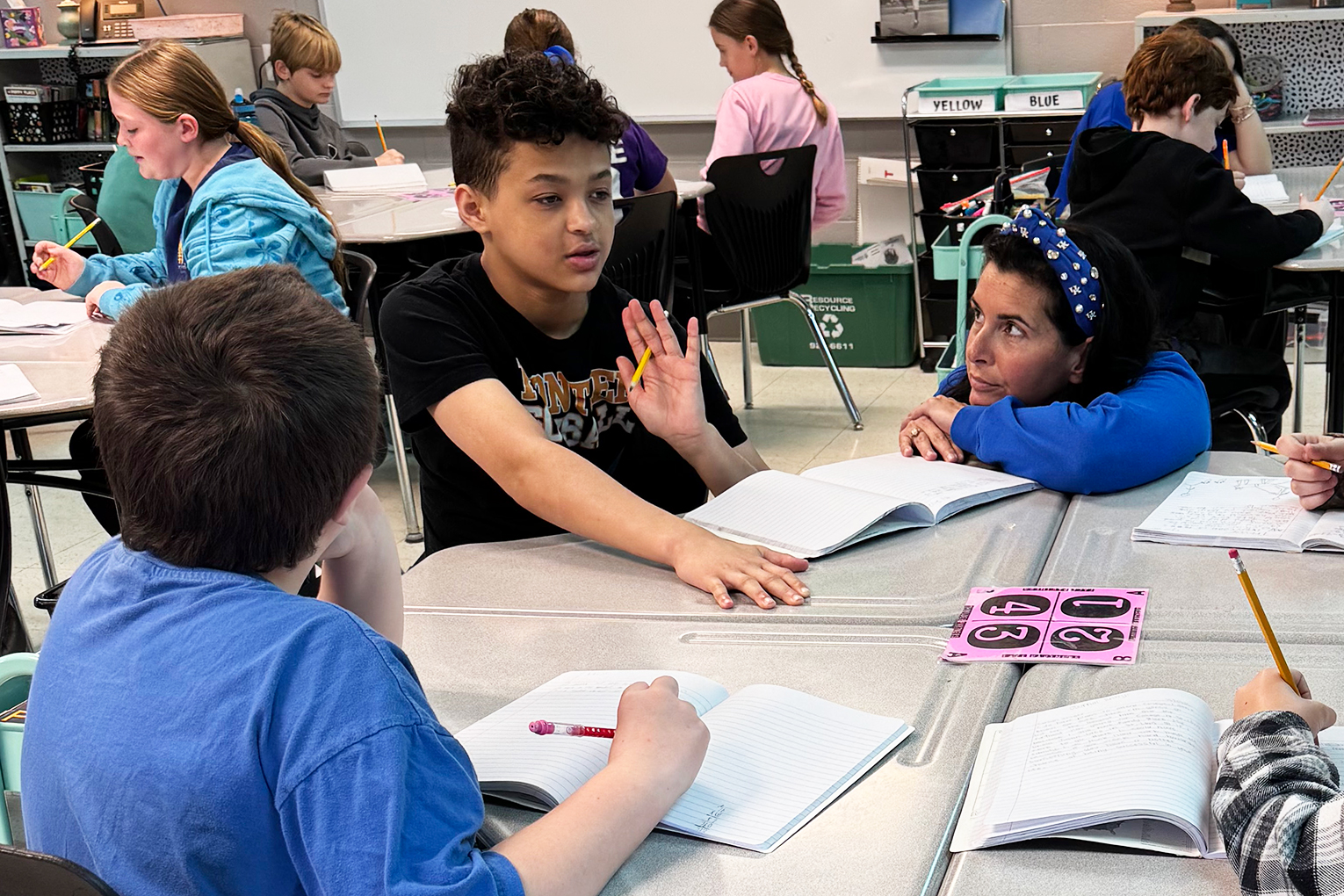
Diane Polley, a health and physical education teacher at Fern Creek High School (Jefferson County), helps students carry CPR practice dummies to the gym. A state law passed earlier this year mandates CPR instruction as a requirement for graduation.
Photo by Bobby Ellis, Sept. 23, 2016
By Mike Marsee
michael.marsee@education.ky.gov
Two years ago, one of Diane Polley’s students at Fern Creek High School (Jefferson County) learned how to perform CPR in health class. Last year, that student saved his grandfather’s life.
More than 30,000 Kentucky students soon will get that training each year as Kentucky schools implement a new law that effectively makes CPR training a graduation requirement. Schools and districts are left to decide how to meet the requirements of Senate Bill 33, which was enacted by the General Assembly earlier this year and took effect when the current school year began.
Some schools and districts have launched their own programs, while others have turned to outside organizations for help. Audra Deli-Hoofnagle, a strategic priorities consultant in the Coordinated School Health branch of the Kentucky Department of Education’s Division of Program Standards, said CPR was already part of the Kentucky Academic Standards for Practical Living for high school students.
“CPR and first aid have always been in our standards, so it’s nothing new that schools and teachers have to teach. It’s just making sure that students are taught those standards,” Deli-Hoofnagle said.
Fern Creek and the other high schools in Jefferson County already had a plan in place thanks to the efforts of Dr. Bill Dillon and his Start the Heart Foundation.
Dillon, a Louisville cardiologist who worked with the American Heart Association to get SB 33 passed, helped launch the Start the Heart Foundation in May 2014 and began offering CPR training in Louisville that summer. He said providing CPR training in schools is ideal, and the foundation now focuses on that during the school year.

James Mambu, left, Josh Eddings and Zander Makon practice hands-only CPR on dummies during a class put on by the Start the Heart Foundation at Fern Creek High School (Jefferson County).
Photo by Bobby Ellis, Sept. 23, 2016
“This is what schools are supposed to do, in my opinion,” Dillon said. “It’s a great basic life skills to have, like learning to swim or to drive a car, and it’s a great thing to be taught in the schools. If students are taught one time, they’re 50 percent more likely to act in the future if someone needs CPR at any time.”
Polley concurs, and she said the new law has changed little in her classes.
“I’ve always done something with CPR, and I think it’s a very important skill,” she said. “I think it’s important that all kids get it.”
Dillon and his foundation are working to make that happen, at least in their corner of Kentucky. Two teams of interns, many of them pre-med students, go into health and physical education classes every Friday in Jefferson, Bullitt, Oldham, Shelby, Spencer and Trimble counties.
They teach hands-only CPR, which since 2010 has been the American Heart Association-recommended means by which people who are not medical personnel should administer CPR.
“It’s a lot easier to teach and not as expensive,” Dillon said.
Dillon said that hands-only CPR is better than no CPR at all, because it can keep a patient alive until emergency personnel can reach him or her. That was the case for Polley’s former student, who worked to keep his grandfather alive while someone called 911.
“He said it just kind of kicked in, and he did only hands-only CPR. The doctors told him he saved his grandfather’s life,” Polley said.
The American Heart Association estimates that CPR must be taught to an average of 1,000 people for one person to use it within a year. Dillon said the Start the Heart Foundation is approaching 18,000 people taught in just over two years, and he is aware of six lives that have been saved as a result of those trainings.
Dillon said the Kentucky Board of Emergency Medical Services has offered to teach CPR to students in smaller districts, and hospitals and other organizations also have offered to go into schools in many districts at no charge.
Deli-Hoofnagle said KDE has directed schools and districts to the American Heart Association’s Be the Beat website, which offers teachers and school administrators free tools and resources to teach CPR programs in schools.
Schools are teaching CPR themselves in districts such as Madison County, where district nursing director Rebecca Carr and Clark-Moores Middle School wellness teacher Mike Crafton launched a pilot program last year to teach hands-only CPR at that school. The district purchased the necessary equipment and Crafton taught his students throughout the second semester.
This year he has shifted the schedule, teaching it every nine weeks in his health class so students in grades 6-8 get the lesson once each year and three times before they leave the school.
“It’s gone really well,” Crafton said. “It’s so easy. In 45 minutes, a kid can at least get a decent understanding and learn the proper way to do hands-only CPR.”
Crafton said he told his students they’re far more likely to use CPR at home than at school, where staff members are trained in CPR.
“If Mom or Dad or Grandpa or Grandma collapse and aren’t breathing, this is good for until paramedics get there,” he said.
MORE INFO …
Mike Crafton mike.crafton@madison.kyschools.us
Diane Polley diane.polley@jefferson.kyschools.us
Dr. Bill Dillon starttheheartfoundation@gmail.com




Leave A Comment